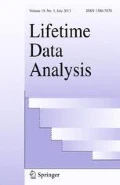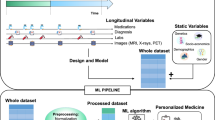Abstract
The recurrent/terminal event data structure has undergone considerable methodological development in the last 10–15 years. An example of the data structure that has arisen with increasing frequency involves the recurrent event being hospitalization and the terminal event being death. We consider the response Survival-Out-of-Hospital, defined as a temporal process (indicator function) taking the value 1 when the subject is currently alive and not hospitalized, and 0 otherwise. Survival-Out-of-Hospital is a useful alternative strategy for the analysis of hospitalization/survival in the chronic disease setting, with the response variate representing a refinement to survival time through the incorporation of an objective quality-of-life component. The semiparametric model we consider assumes multiplicative covariate effects and leaves unspecified the baseline probability of being alive-and-out-of-hospital. Using zero-mean estimating equations, the proposed regression parameter estimator can be computed without estimating the unspecified baseline probability process, although baseline probabilities can subsequently be estimated for any time point within the support of the censoring distribution. We demonstrate that the regression parameter estimator is asymptotically normal, and that the baseline probability function estimator converges to a Gaussian process. Simulation studies are performed to show that our estimating procedures have satisfactory finite sample performances. The proposed methods are applied to the Dialysis Outcomes and Practice Patterns Study (DOPPS), an international end-stage renal disease study.

Similar content being viewed by others
References
Andersen PK, Gill RD (1982) Cox’s regression model for counting processes: a large sample study. Ann Stat 10:1100–1120
Andersen PK, Klein JP, Rosthøj S (2003) Generalised linear models for correlated pseudo-observations, with applications to multi-state models. Biometrika 90:15–27
Breslow NE (1972) Contribution to the discussion of the paper by DRCox. J R Stat Soc Ser B 34(2):216–217
Carson RC, Juszczak M, Davenport A, Burns A (2009) Is maximum conservative management an equivalent treatment option to dialysis for elderly patients with significant comorbid disease? Clin J Am Soc Nephrol 4(10):1611–1619
Cook RJ, Lawless JF (1997) Marginal analysis of recurrent events and a terminating event. Stat Med 16(8):911–924
Cook RJ, Lawless JF, Lakhal-Chaieb L, Lee KA (2009) Robust estimation of mean functions and treatment effects for recurrent events under event-dependent censoring and termination: application to skeletal complications in cancer metastatic to bone. J Am Stat Assoc 104(485):60–75
Cox DR (1972) Regression models and life tables (with discussion). J R Stat Soc 34:187–220
Cox DR (1975) Partial likelihood. Biometrika 62:269–276
Estes JP, Nguyen DV, Dalrymple LS, Mu Y, Şentürk D (2015) Time-varying effect modeling with longitudinal data truncated by death: conditional models, interpretations, and inference. Stat Med 35:1834–1847
Fine JP, Gray RJ (1999) A proportional hazards model for the subdistribution of a competing risk. J Am Stat Assoc 94(446):496–509
Fine JP, Yan J, Kosorok MR (2004) Temporal process regression. Biometrika 91(3):683–703
Ghosh D, Lin D (2000) Nonparametric analysis of recurrent events and death. Biometrics 56(2):554–562
Ghosh D, Lin DY (2002) Marginal regression models for recurrent and terminal events. Stat Sin 12:663–688
Grand MK, Putter H (2016) Regression models for expected length of stay. Stat Med 35(7):1178–1192
Gray RJ (1988) A class of k-sample tests for comparing the cumulative incidence of a competing risk. Ann Stat 16:1141–1154
Holland DC, Lam M (2000) Predictors of hospitalization and death among pre-dialysis patients: a retrospective cohort study. Nephrol Dial Transplant 15(5):650–658
Hu XJ, Lorenzi M, Spinelli JJ, Ying SC, McBride ML (2011) Analysis of recurrent events with non-negligible event duration, with application to assessing hospital utilization. Lifetime Data Anal 17(2):215–233
Huang CY, Wang MC (2004) Joint modeling and estimation for recurrent event processes and failure time data. J Am Stat Assoc 99(468):1153–1165
Kalbfleisch JD, Prentice RL (2002) The statistical analysis of failure time data, 2nd edn. Wiley, New York
Kalbfleisch JD, Schaubel DE, Ye Y, Gong Q (2013) An estimating function approach to the analysis of recurrent and terminal events. Biometrics 69(2):366–374
Lewis JA (1999) Statistical principles for clinical trials (ich e9): an introductory note on an international guideline. Stat Med 18(15):1903–1942
Lin D, Ying Z (1994) Semiparametric analysis of the additive risk model. Biometrika 81(1):61–71
Lin DY, Wei LJ, Yang I, Ying Z (2000) Semiparametric regression for the mean and rate functions of recurrent events. J R Stat Soc Ser B (Stat Methodol) 62(4):711–730
Little RJ, Rubin DB (2002) Statistical analysis with missing data. Wiley, New York
Liu L, Wolfe RA, Huang X (2004) Shared frailty models for recurrent events and a terminal event. Biometrics 60(3):747–756
Mao L, Lin DY (2016) Semiparametric regression for the weighted composite endpoint of recurrent and terminal events. Biostatistics 17(2):390
Neaton JD, Gray G, Zuckerman BD, Konstam MA (2005) Key issues in end point selection for heart failure trials: composite end points. J Cardiac Fail 11(8):567–575
Peng L, Huang Y (2007) Survival analysis with temporal covariate effects. Biometrika 94(3):719–733
Pfeffer MA, Swedberg K, Granger CB, Held P, McMurray JJ, Michelson EL, Olofsson B, Östergren J, Yusuf S, Investigators C, Committees, et al (2003) Effects of candesartan on mortality and morbidity in patients with chronic heart failure: the charm-overall programme. Lancet 362(9386):759–766
Sands JJ, Etheredge GD, Shankar A, Graff J, Loeper J, McKendry M, Farrell R (2006) Predicting hospitalization and mortality in end-stage renal disease (esrd) patients using an index of coexisting disease (iced)-based risk stratification model. Dis Manag 9(4):224–235
Schaubel DE, Cai J (2006) Multiple imputation methods for recurrent event data with missing event category. Can J Stat 34(4):677–692
Schaubel DE, Zhang M (2010) Estimating treatment effects on the marginal recurrent event mean in the presence of a terminating event. Lifetime Data Anal 16(4):451–477
Schaubel DE, Zeng D, Cai J (2006) A semiparametric additive rates model for recurrent event data. Lifetime Data Anal 12(4):389–406
Scheike TH, Zhang MJ (2007) Direct modelling of regression effects for transition probabilities in multistate models. Scand J Stat 34(1):17–32
Yan J, Fine JP (2005) Functional association models for multivariate survival processes. J Am Stat Assoc 100(469):184–196
Yan J, Huang J (2009) Partly functional temporal process regression with semiparametric profile estimating functions. Biometrics 65(2):431–440
Ye Y, Kalbfleisch JD, Schaubel DE (2007) Semiparametric analysis of correlated recurrent and terminal events. Biometrics 63(1):78–87
Young EW, Goodkin DA, Mapes DL, Port FK, Keen ML, Chen K, Maroni BL, Wolfe RA, Held PJ (2000) The dialysis outcomes and practice patterns study (dopps): an international hemodialysis study. Kidney Int 57:S74–S81
Zeng D, Cai J (2010) A semiparametric additive rate model for recurrent events with an informative terminal event. Biometrika 97:699–712
Zhu L, Zhao H, Sun J, Pounds S (2014) A conditional approach for regression analysis of longitudinal data with informative observation time and non-negligible observation duration. Commun Stat Theory Methods 43(23):4998–5011
Acknowledgements
This work was supported in part by National Institutes of Health Grant R01 DK070869 and by an M-Cubed Grant from the University of Michigan. The DOPPS is administered by Arbor Research Collaborative for Health and supported by scientific research grants from Amgen (since 1996), Kyowa Hakko Kirin (since 1999, in Japan), Sanofi Renal (since 2009), Abbott (since 2009), Baxter (since 2011), and Vifor Fresenius Renal Pharma (since 2011), without restrictions on publications. The authors thank Arbor Research Collaborative for Health for providing access to the DOPPS data and, in particular, Keith McCullough for creating the analysis files.
Author information
Authors and Affiliations
Corresponding author
Electronic supplementary material
Below is the link to the electronic supplementary material.
Appendix
Appendix
We first list notation that appeared in Sect. 3.1:
Formulas pertaining to Sect. 3.2 are as follows:
Rights and permissions
About this article
Cite this article
Zhan, T., Schaubel, D.E. Semiparametric temporal process regression of survival-out-of-hospital. Lifetime Data Anal 25, 322–340 (2019). https://doi.org/10.1007/s10985-018-9433-8
Received:
Accepted:
Published:
Issue Date:
DOI: https://doi.org/10.1007/s10985-018-9433-8




